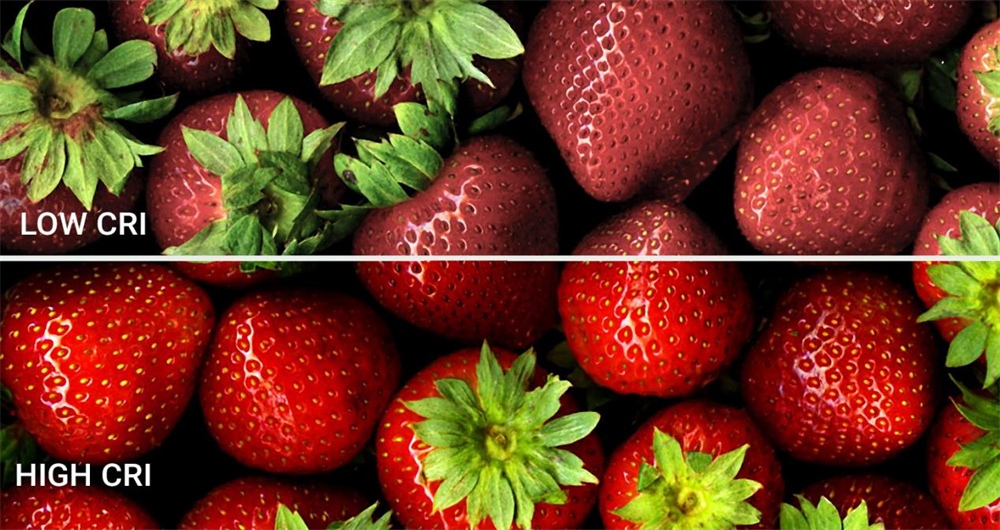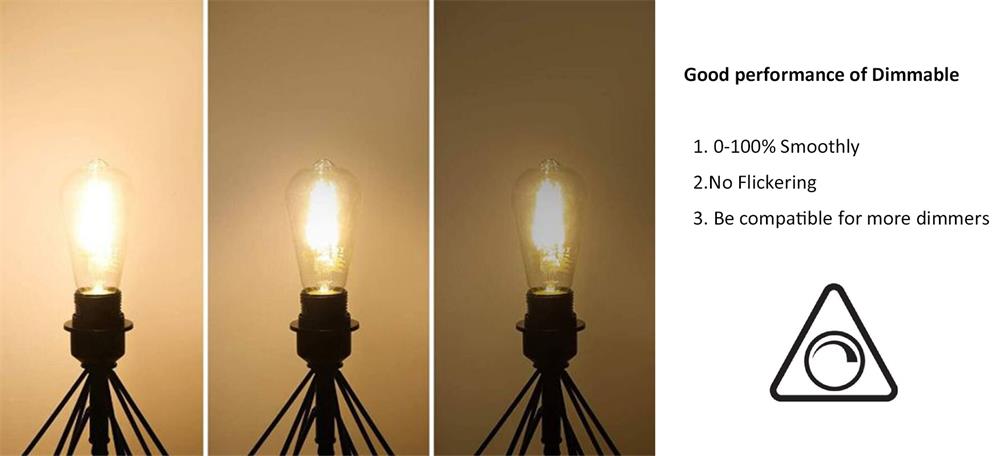This article going to tell 7 most important Parameters of LED Edison bulb. Which help you to get enough info for buying a led Edison bulb or even working as a professional purchasing or products manager of light bulbs.
With the enhancement of our awareness of environmental protection and the popularization of LED bulbs, LED bulbs have entered everyone’s field of vision replaces incandescent light bulbs.
Incandescent lamps are also called electric light bulbs. Its working principle is that heat is generated when the current passes through the filament, and the spiral filament continuously gathers the heat, making the temperature of the filament more than 2000 degrees Celsius. When the filament is in an incandescent state, it is like red-hot iron can emit light. The higher the temperature of the filament, the brighter the light emitted, so it is called an incandescent lamp. When an incandescent lamp emits light, a large amount of electrical energy is converted into heat energy, and only a very small amount can be converted into useful light energy.
LED lights, also known as light-emitting diodes, are solid-state semiconductor devices that can directly convert electricity into light.
LED electric energy converts light energy, and generates very little thermal radiation, and most of the energy is directly converted into light energy. Therefore, compared with incandescent bulbs, LED bulbs are more energy-efficient under the same amount of light.
Led Edison bulbs are energy-saving, long life, and high safety features that makes LED Edison bulbs(Led filament bulb) replace incandescent bulbs in many usage scenarios.
Because of their many advantages, people are trend to buy LED Edison bulbs, before buying a LED Edison light bulb, you must understand the basic parameters of LED Edison bulbs, so that you can find the right light bulb when you are choosing.
Parameters you have to know for Choosing LED Edison Bulbs
*Lumen
*Correlated Color temperature (CCT)
*Color Rendering Index(CRI)
*Watt
*Power Factor
*Dim
*Hours(Lifespan)
*Lumen (brightness):
The amount of light emitted from a light bulb is measured in Lumen. We know that when we buy incandescent light bulbs we focus their wattage and to determine how bright the bulb is. A 60-watt incandescent light bulb can produce 810 lumen of light, but an LED Edison bulb only needs about 7 watts to reach 810 lumen. Therefore, when we want to pay attention to the brightness of the lamp when buying LED Edison bulbs, we should mainly focus their lumen. Do not use watts as a measure of a led bulb brightness.
How many lumen is right for you?
This is also related to the usage scene, room size and shape, height of ceilings, colour scheme, type of lamps & fitting.
|
How many lumen is right for you? |
|
|
Area |
Lumen / Sq Meter |
|
Kitchen |
300-400 |
|
Living Room |
400-500 |
|
Bedroom |
300-400 |
|
Bathroom |
500-600 |
|
Reading Area |
400 |
|
Hallway |
300 |
*Correlated Color temperature (CCT):
Color temperature is a way to describe the light appearance provided by a light bulb. Actually, Color temperature is the absolute black body with different temperatures to produce different colors, measured in Kelvin. It can refer to the warmness or coolness of the light that bulb produces.
Normally, In our daily life, the correlated color temperature used in both residential lighting and commercial lighting is between 2000K and 6500K.
What color temperature is right for you?
Understanding the characteristics of different color temperatures and suitable different scenes is very helpful for us to choose the color temperature that suits us.
From 2000K to 3000K, the light produced is called “warm white”.
Between 3100K and 4500K are referred to as “cool white” or “bright white.”
Cool white starts from around 6000k upwards.
1700K:Match Light, Flame Light
1850K:Candle Light, Sunset and Sunrise
2550K:Incandescent Lamp (Tungsten Filament Lamp)
3000K:Halogen Lamp
3200K:Studio Light
4000K:Natural Light, Moonlight, Light Yellow Fluorescent Light
5000K:Horizon Daylight
6000K:Daylight / Full Spectrum
6500K:Common White Fluorescent Lamps
6500K-9500K:LCD、CRT Screen
15000K-27000K:Clear Blue Sky
The specific choice can be selected according to the usage, location and your own visual feeling. Choosing the right color temperature is very helpful for the atmosphere and visual effects of the entire interior.
Suggestions as below:
Living rooms & bedrooms: warm white 2700k
Bathrooms & entryways: warm white 3000k
Basements & garages : cool daylight 5000k
*Color Rendering Index (CRI)
The color rendering index of a light bulb is the true degree to which the color of a colored object is displayed when illuminated by the light bulb. The lighting with high color rendering can restore the authenticity of the object to a higher degree and more beautiful.
CRI below 80: The color rendering below 80 of a bulbs which can not render a “true” light, it would be considered to have poor color rendering, especially below 70, it is sometimes difficult to distinguish similar colors (like:black and dark blue).
CRI 80-90: Pretty well color rendering, where most colors are rendered well. Commercial light bulbs and residential light bulbs their CRI are most in this range.
CRI 90-100: Lighting with a CRI high 90 would be considered to have phenomenal color rendering. Incandescent lamps and daylight have a CRI of 100, the highest possible CRI.
*Watt
Different from incandescent bulbs, when we buy LED bulbs we look at the power of the bulb not the brightness of the bulb, but more about the energy consumed by the bulb. The lower the watts, the lower the electric bill.
Generally, the wattage of common led bulbs is below 12 watts, 3w-10w is in common. LED sources are much more efficient at converting watts to lumen. So it’s wattage lower than incandescent bulbs but the lumen achieved are comparable to tens of watts of incandescent bulbs. Incandescent lamps have ended the 145-year lighting history of incandescent lamps in EU countries, since September 1, 2022, but people in many countries and regions around the world are still using incandescent bulbs. If we really want to ditch incandescent lamps and use more energy-efficient LED lamps, how can the wattage between them be converted to achieve similar lumen?
Please find the table as follows:
LED Edison bulbs Watts equal to Incandescent bulb
|
LED Bulb |
Incandescent Bulb |
Lumen |
|
1w |
15w |
100lm |
|
4w |
40w |
470lm |
|
7w |
60w |
810lm |
|
15w |
100w |
1600lm |
*Power Factor
Power Factor means under a certain voltage and power, the higher the PF value, the higher the conversion rate of electricity, and the more fully utilized the power generation equipment, the ratio as a percentage. Most equipment systems have reactive power loss.
Among 100 units of power input equipment, only 70 units can be used, so the power factor of this equipment 0.7.
When we choose LED bulbs, the PF usually marked on the packaging. We must pay attention to buying high PF value.
|
Parameter of LED Edison Bulbs |
|||
|
Parameter |
Average |
Good |
Best |
|
Lumens/Watt |
75 |
90 |
100 |
|
Power Factor |
0.7 |
0.8 |
0.9 |
|
CRI |
60 |
70 |
80 |
|
LED Life in Hours |
15000 |
25000 |
50000 |
*Dim
LED Edison bulbs were not dimmable in the past. Now, many manufacturers in order to meet people’s diverse needs they produced many dimmable bulbs. Normally, When we say LED Edsion Bulb be dimmable which means its Brightness(Lumen) can be adjusted from low to high by a led dimmer.A Good Dimmable performance Led Edison light up and down smoothly and without any flickering during it be dimmed most led dimmer. Please note, any dimmable LED Edison Bulb can not be compatible to all dimmer in Mark, More knowledge of Dim
*Hours (lifespan)
Many manufacturers will test the life of the bulb when it is produced, and these parameters can be easily found on the packaging.
LED Filament bulbs (LED Edison Bulb) can be used for 50,000 hours in general instructions, and some manufacturers even advertise that their bulb life can reach 100,000 hours. This is because LED bulbs do not simply cease to function, and their service life cannot be calculated using traditional measures. During actual testing by a light bulb manufacturer, it’s not waiting for bulbs to stop working, but there are other ways to measure it. LED Edison bulbs have a long lifespan because they don’t fuse the filament.
LED Edison bulbs don’t stop functioning over time, but their brightness gradually fades. Professional predictions show that a high-quality light bulb can still reach 60% of its initial brightness after 50,000 hours of operation. When the bulb reaches its rated life it may still glow but the light will be very weak.
Therefore, you should focus on the “hours” on the packaging when you are choosing.
I hope this information helps you the next time you go bulb shopping or even make big Purchasing decision with supplier.
Post time: Nov-08-2022





